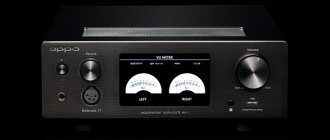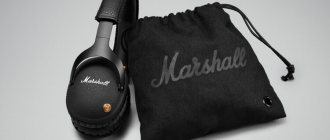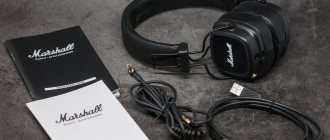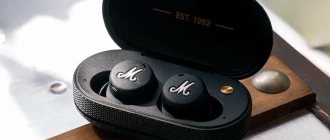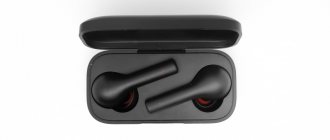Hello, dear readers. A few years ago, OPPO released planar magnetic headphones PM 1, which quickly gained recognition among lovers of high-quality sound. The model collected a number of prestigious awards, but did not become truly widespread due to its high cost. Then the cheaper PM 2 model was introduced, but the price tag for it still remained quite high.
Finally, Oppo pm 3 headphones were released onto the market, which will be discussed in the review. They also belong to the category of Hi-End devices, but have an affordable price.
Headphone Features
It was not for nothing that we mentioned PM 1 at the very beginning of the review. OPPO engineers decided to experiment and practically brought back Orthodynamic technology from oblivion, a feature of which is the use of planar magnetic moving drivers. This is not a new technology; it was in demand in the 70s of the last century, but then was gradually replaced by other technological solutions.
The Chinese company OPPO presented Hi-End headphones with planar magnetic drivers, and the PM 1 model, in addition to its unique technology, was also distinguished by its high price. For most audiophiles, the cost of the PM 1 turned out to be excessive (the model still sells for $1000-1100), although most reviews gave the headphones high marks.
Model PM 3 is intended for the mass market. It is 2.5-3 times cheaper, but at the same time retains high build quality, is made of metal, leather and high-quality polycarbonate and, most importantly, has an unusual original sound.
Interestingly, although headphones perform best in conjunction with a good amplifier and player, they can also be used with a smartphone.
PM 1 also provided the ability to connect to mobile devices. In PM 3, the developers went even further and specifically focused on working in tandem with smartphones. We used an iPhone 6 for testing.
PM 3 differs from PM 1 and PM 2 in the reduced size of the planar orthodynamic drivers. While older models use oval drivers measuring 85x69mm, the PM 3 has round drivers with a diameter of 55mm. Since reducing the size of the driver could noticeably worsen the sound quality, OPPO engineers developed a different magnetic system and a seven-layer membrane. As a result, the sound quality was not affected.
The price was further reduced by eliminating the luxurious wooden case in which the PM 1 is packaged. The younger model comes in a cardboard box.
Note that the color range has become wider. PM-3 is available not only in classic black, but also in white.
Build quality
The build quality is high. You can compare PM 1, PM 2 and PM 3 for a long time, and still not be able to determine which version is better assembled. There is absolutely nothing to complain about.
Positioning
The PM 1 were positioned as headphones for enthusiasts willing to shell out a pretty penny for unusual technology. After the flagship model received a lot of rave reviews, it became clear that the product line needed to be developed, and, if possible, to make it cheaper, but without sacrificing quality.
This is how the PM 3 model appeared. It is noticeably cheaper than the founder of the series, but is still capable of conveying all the nuances of a musical composition. Music does sound different on the PM 3 than on most headphones. However, we will return to describing the nuances of sound in the review.
Another important aspect is the use of PM 3 in conjunction with mobile devices. At first, this seems strange, because the full potential of headphones can only be realized on Hi-End equipment.
However, the headphones play surprisingly well on smartphones, leaving the popular Beats Pro far behind in sound quality.
The closed design allows them to be used even on a noisy street; external noise does not penetrate the ear pads. What’s important is that you can’t hear the music playing on your headphones outside either.
The resistance of PM 3 is only 26 Ohms (older models have a resistance of 32 Ohms), that is, any mobile device can drive the headset. OPPO positions headphones as a universal solution, capable of conveying all the nuances of compositions regardless of the conditions surrounding the listener.
Compatibility
Basically, the PM-3 was designed to be a universal headphone that can be connected to anything. The low impedance, good sensitivity and plenty of cables included immediately make it clear that mobile devices can be used with these headphones. I tried them with an iPhone 6 Plus, the result is not bad, as much as the iPhone itself allows, but compared to professional sources, of course, tablet phones are noticeably inferior. Oppo also understood this fact very well and therefore made a good portable DAC/amplifier HA-2 for the PM-3. I have not yet had the opportunity to familiarize myself with it, but, according to reviews, this combination shows more than decent results. In general, PM-3s benefit from a quality source, so I would recommend using some kind of mid-price DAC or player with them (powerful amplification and top-end models are not really needed for them).
The headphones are very tolerant of recording quality; a carefully thought-out frequency response makes them very tolerant of recording flaws and not very high-quality formats, although you will still hear their shortcomings.
Traditionally, several tracks.
James Brown - Night Train. Live at the Apollo is not without reason considered one of the best live recordings in music history. It’s the energy of the concert that makes it so strong; it’s rare that musicians communicate so closely with the audience, and this track is a prime example of this. Unfortunately, the 1962 recording does not have the quality that is inherent in modern equipment, but the careful presentation of the PM-3 just allows you to level out technical problems and completely immerse yourself in the live atmosphere of that time.
Annihilator - My Precious Lunatic Asylym. It is Jeff Waters who we have to thank for the transition of the thrash metal scene from speed to quality.
Most of the classics of the genre realized after Annihilator that just playing at the speed of a Japanese sawmill is not enough for success. The works of Annihilator themselves are almost always a fusion of driving riffs, interesting melodies, unexpected moves and great technical performance. This track is no exception; I often use it as a test track. It makes it very clear whether certain headphones are going overboard with the emphasis on low frequencies and whether they are not throwing everything into mush. PM-3 is, of course, not a record breaker here, but for a closed model they do an excellent job. Porcupine Tree - Cheating the Polygraph. Stephen Wilson is one of those magicians who you don’t want to call a composer, since he rather constructs his music, collecting unexpected harmonies and heterogeneous moves that act directly on the subconscious. This multi-faceted track at its high-speed moments requires exactly the same presentation as this Oppo model to fully convey all the energy, and the headphones do an excellent job with this.
Equipment
The set is traditionally rich. OPPO bundles its headphones with a wide range of accessories. Model PM-3 is packaged in two boxes. The outer box is quite large, inside it there are boxes with cables, as well as a box with headphones. The kit includes:
- Headphones
- Carrying case
- Cable 3 m (6.3 mm connector)
- 1.2 m cable for connecting to Android devices
- 1.2 m cable for connecting to iPhone/iPad
- Cable 1.2 m (6.3 mm connector)
- Documentation
The cables are removable and connect to the headphones via a 3.5 mm jack, so they can be easily replaced if necessary. Cables for mobile devices are equipped with remote controls and a microphone, that is, the model can be used as a headset. And, by the way, PM 3 copes with this role perfectly.
The speech quality is beyond praise, which is not surprising, since working with the performer’s voice is one of the characteristic features of planar magnetic headphones.
Speaker vs isodynamic
It just so happens that only one half of the headphones in the test have traditional dynamic drivers, while the other half are isodynamic or, as it has now become fashionable to call them, “magnetic planar”. With a conventional speaker, everything is generally clear: a round magnet, in its field there is a round coil, which is attached to the diffuser and moves it back and forth. In isodynamic drivers, the role of a voice coil is performed by conductive tracks applied directly to the surface of a flat diffuser located between two magnetic gratings.
The dynamic driver has a large stroke, but the acoustic filters that dampen it (left) reduce detail
Isodynamic emitters have the best electrical characteristics due to the minimal inductance of the conductive paths. In addition, they are able to provide a smoother frequency response and a lower level of distortion due to the fact that the driving force is transmitted to the surface of the diffuser evenly, and not in one zone, as in a dynamic radiator.
The isodynamic driver can be completely open, which is good for detail, but the maximum aperture travel is limited
But since the diffuser of an isodynamic radiator is located in a small space between two magnets, it cannot have a large stroke, and therefore provide a large sound pressure per unit area. This means that to obtain the same volume, the diffuser area of an isodynamic emitter must be larger than a traditional dynamic one.
Design and convenience
The design solutions used in the PM 1 and PM 2 models are fully reflected in the PM 3. This is not surprising, because the Chinese company sought to maintain continuity of styles and emphasize the similarity of the new headphones with well-known and expensive predecessors. Both the design and construction remained virtually unchanged.
There is still a lot of metal from which many elements are made. In particular, the rotating mechanisms, headband, and outer sides of the bowls are metal. Since the headphones are closed, the ear pads have no holes. The ear pads themselves are leather and, unfortunately, non-removable. You won't be able to replace them yourself.
The headphones look strict, elegant, and reliable. The metal linings of the bowls have an interesting longitudinal corrugation. It’s almost impossible to make out in photographs or videos, but in real life the texture is clearly visible. Interestingly, the white model does not have such corrugation, the surface of the linings is smooth.
We had some concerns about the PM 1's ease of use. These are closed-back headphones, after all, and we were concerned that the ear cups would put too much pressure on the ear, causing discomfort. The fears turned out to be unfounded. The cups do not press, the auricle fits completely into them, in addition, the inside of the ear pads is very soft. The extendable headband allows you to quickly adjust the size.
The weight is 320 grams, which is not small for a headset used with mobile devices. On the other hand, the older PM 1 weighs about 400 grams, and we didn't have any problems with them during testing. PM 3 is noticeably lighter, although they cannot be called weightless. And yet, even with prolonged wear, the head and neck do not get tired of them.
The rotating mechanisms are reliable (at least that is the impression they give) and convenient. Their design allows the bowls to be rotated with little effort. When folded, the PM 3 fits into the included case. You can also lay cables in it.
In older models, cables were connected to the bowls via 2.5 mm inputs. Each bowl had a connector. The new device has only one connector for connection, and it is a standard 3.5 mm input.
Audeze LCD-XC
Forget everything I said about the heavy weight of the Sonus Faber Pryma 01 and OPPO PM3. I confess I was too strict. That's because it came down to the Audeze LCD-XC, also known as "650 grams of audiophilia on your head." Large soft ear pads that cover the entire ears and a wide headband make the situation a little easier, but they are still a bit difficult to wear. Despite the actual compatibility of the headphones with a smartphone, I probably won’t go outside wearing them. In addition, the carrying case looks like a jigsaw box, and quite naturally - its dimensions are even more monstrous than the dimensions of the headphones themselves.
But you don’t need to explain to anyone that the Audeze LCD-XC is a real High End. They look great. Wooden earcups can be chosen to suit your taste, the color of the furniture or the nature of the sound, and different types of wood give the sound a truly varied coloring.
The attachment of the earcups to the headband is quite movable, which is convenient when using them. The cable connection points are organized in the only correct way with a forward slope so that the connectors and cables do not interfere under any circumstances. The elements for attaching the cups to the headband do not look particularly powerful or reliable, so it is better to use the Audeze LCD-XC carefully. The mini XLR connector type is usually used in professional equipment, but, as practice has shown, it will not be difficult to find a worthy alternative to a standard cable.
Specification data Emitter type - isodynamic (magnetic planar) Emitter diameter - 106 mm Acoustic design - closed Frequency range - 5-50000 Hz Impedance - 20 Ohm Distortion level - less than 1% (over the entire operating range) Sensitivity - 100 dB Sound pressure - 130 dB Cable connection - two-way Pressure of headphones on the head - no data Weight - 650 g
Sound
Now we come to the most important aspect. We had no complaints about the design, build quality, quality of materials used and ease of use. There are no problems with sound quality either. For the test, we used compositions from different directions and genres; we did not specifically limit ourselves, but included a number of vocal recordings (opera and jazz).
We connected our ears directly to the iPhone 6, because this use case will probably be one of the most common. The volume reserve turned out to be even excessive; the smartphone copes with PM 3 without any problems. However, much more important is the fact that the sound turned out to be clean and transparent. It did not become rough, as often happens when high-quality headphones are connected to a mobile device.
We did not use an equalizer, all frequencies turned out to be balanced. The PM-3 did an excellent job with vocal compositions. The vocals are moved to the foreground and the emphasis is placed on the voice.
The sound stage expands, creating the very presence effect for which Hi-End and Hi-Fi equipment is purchased. The musical instruments present on the recording are clearly distinguished and can be easily identified in the general flow of sound. The sound is emotional, with good detail.
Bass is slightly elevated. This was probably done in order to compensate for possible interference coming from the street. Well, let's not deny the obvious - many mobile music lovers value low frequencies, so OPPO only met the wishes of customers. However, there is no “pressing” bass, so you don’t have to worry about this.
The quality of sound insulation can be assessed as high. Sound breaks through only at maximum volume levels. Accordingly, if you don’t listen to loud music, you can use your ears even in a quiet office without fear of disturbing your colleagues.
Of course, when connected to professional sound sources, the sound becomes noticeably higher quality, more interesting, more nuances appear, the scene acquires additional depth and detail.
Smartphones cannot even come close to competing with normal DACs. But since OPPO PM 3 is a universal product, we were interested in testing them in conjunction with mobile devices. And the result did not disappoint us.
Sound
The following equipment was used for listening:
- Yulong DA8 and Resonessence Labs Concero HP as a DAC and amplifier
- Apple MacBook Pro Retina 2013 as a source
- Fidelia as a player
- Fiio X5-2 and Cayin N6 as portable players
- High-resolution recordings in Lossless formats (Dr. Chesky The Ultimate Headphone Demonstration Disc and others)
Before assessing the sound, the headphones were warmed up for 48 hours.
Releasing a closed model is always a challenge, since the closed volume of the cups always requires special measures to compensate. Without planning for this, the output will be a buzzing and dark sound that causes claustrophobia. The developers of the PM-3 tried to take this into account, but, of course, a number of compromises had to be made in connection with the closed acoustic design; this was inevitable. The sound of the headphones turned out to be very neutral, without pronounced accents, with a pleasant and comfortable sound. The neutrality of these headphones is such that sometimes they even seem a little bland, this is very unusual for a closed model, although I don’t find this a big problem, since you can add flavor by selecting the source, but removing excess “fat” is more difficult.
The bass in this model is slightly raised, just a little. First of all, this was done to compensate for extraneous interference on the street (it is at low frequencies that noise best penetrates through the earcups), and secondly, this sound is now in favor, most people like “more low-end”. An interesting feature of the PM-3 is their criticality to the tightness of the ear pads, for example, even small gaps, inevitable when using glasses, lead to a slight decrease in bass frequencies. If you feel that there is not enough bass in the PM-3, you should try moving the earcups a little and finding a position with maximum fit. Of course, the RM-3 in any case will not be “basshead” headphones, their bass depth is not bad, but not prohibitive, and they do not have oppressive bass, everything is restrained, intelligent, with good resolution, speed and detail. Bass processing is highly dependent on the source and shows flaws in this area quite noticeably.
From all the measurements available on the Internet, it is noticeable that the frequency response of the headphones was designed to be as close as possible to the curve adopted as the Harman company standard (a slight rise in the low frequencies and more noticeable in the 3 KHz region). According to the company's research, it is this style that gives the most “natural” sound perception. Perhaps this is precisely the reason for the very “boringness” of the PM-3, for which they are sometimes reproached. Because of this frequency response, the mid frequencies of the headphones are perceived quite unusually: vocals are brought to the foreground, the voice and instruments falling within this range are emphasized. On most of the tracks I listened to, this gives the effect of artificially expanding the imaginary scene, at first it seems funny, but quickly becomes boring. On the other hand, the depth of this very imaginary scene is very good, the headphones do a good job of developing plans, and the separation of instruments is also not satisfactory. The emotions embedded in the recording are also conveyed well, as well as small nuances; the detail is very good, although not exorbitant.
The upper frequencies are also carefully adjusted for “comfortable” perception; the area of sibilance, which most often causes criticism, is carefully suppressed, as well as the highest HF. On the one hand, this gives a comfortable, not very annoying sound (yes, there is ringing, there are all sorts of rustling sounds, too, but without unnecessary accents), on the other hand, sometimes you want a little more air, attenuation and small nuances. I understand that with closed headphones you almost certainly have to choose between “trebles that are a little boring” and “trebles that are too fun for the brain,” and, perhaps, like the Oppo engineers, I am inclined to the first option. In addition, the unevenness of the treble makes them feel a little unnatural, but again this is compared to open-back headphones.
Impressions and conclusions
A classic disadvantage of orthodynamic (planar magnetic) drivers is their low sensitivity and, as a consequence, the need to use an amplifier. OPPO engineers managed to cope with this problem - even a smartphone can “boost” the PM-3.
At the same time, the dimensions and weight of the device remained at an acceptable level. It turned out that the technology, successfully forgotten by most manufacturers, still has a chance of life in new conditions and can be used to listen to “mobile” music.
We liked PM 3, and we couldn’t identify any characteristic shortcomings. Don't forget that these are closed-type headphones, and this form factor imposes certain limitations.
It is not always possible to achieve such a natural, smooth sound. The price seems more than justified to us for the sound quality and convenience that the PM 3 can offer.
Verdict
We can say that if you want to spend $400 on over-ear headphones, then look no further than the Oppo PM-3. These are the best headphones we have tested in this price category. They deliver everything you'd expect from a model of this price and will make many of its higher-priced competitors blush.
They are great for listening to music both at home and while walking around the city and are head and shoulders above the competition, including those from major brands. We can't give them a higher recommendation than we already have - they're simply a stunning model.
When preparing the review, materials from www.techradar.com were used (translation from English - hifiNews.RU) Original: https://www.techradar.com/reviews/audio-visual/hi-fi-and-audio/headphones/oppo- pm-3-1299128/review
Prepared based on materials from the portal “HiFiNews.ru”, August 2017
www.hifinews.ru This review was read 7,762 times
